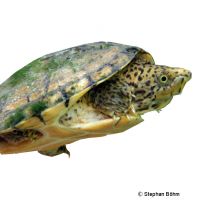Loggerhead Musk Turtle (Sternotherus minor)
| Loggerhead Musk Turtle Sternotherus minor | |
|---|---|
| Name | Loggerhead Musk Turtle |
| Name Lat. | Sternotherus minor |
| Synonym | Kinosternon minor |
| Family | Mud Turtles |
| Family lat. | Kinosternidae |
| Order | Turtles |
| Order lat. | Testudines |
| Origin | North America |
| Habitat | Shallow waters |
| Diet | Insects, fish, plant matter |
| Humidity | 60-80 % |
| Behavior | Semi-aggressive |
| Keeping | Individual |
| Care Level | Easy |
| Reproduction | Oviparous |
| Housing | Aquaterrarium |
| Life Span | 10 years |
| Protection | No |
| Metric Units | |
| Size | 13 cm |
| Temperature | 22-28 °C |
| Temperature Local | 35-40 °C |
| Housing Size | 60 x 40 x 40 cm |
| US Units | |
| Size | 5" |
| Temperature | 72-82 °F |
| Temperature Local | 95-104 °F |
| Housing Size | 25" x 15" x 15" |
Distribution and habitat
The distribution area of the Little Musk Turtle is the southeastern USA (Florida, Alabama, Georgia). There they inhabit stagnant or slow-flowing, plant-rich waters with muddy bottoms and dense riparian vegetation that provides sheltered basking sites.
Maintenance
Minimum dimensions for the aquaterrarium, according to the size and number of animals
| floor space for 1-2 animals: 3PL x 1,5PL (L x W) | Water level: 2PB |
The carapace length (PL) and carapace width (PB) is measured on the largest animal. For each additional animal, increase the footprint by 10%, and for the 5th animal and larger, increase the footprint by 20%. An aquaterrarium of e.g. 60 x 40 x 40 cm is recommended, which should be placed in a quiet place
The water part (about two thirds of the base area) should be structured with a soft substrate of fine gravel, with roots, aquatic plants and larger stones (visual barriers and hiding places), some of which reach the water surface. In addition, the water surface should be covered with numerous floating plants. The terrestrial part with a soft substrate of sand-soil mixture should be equipped with robust plants and roots, as well as provide sunning areas. To maintain water quality, a powerful filter with low flow is recommended, as well as frequent water changes
| Temp. day: 26-28 °C | Temp. night: 20-22 °C | Temp. local: 35-40 °C | Water temp.: 22-24 °C |
The lighting duration should be 10-14 hrs. depending on the season. They need daily UV irradiation and sunny places with radiant heat.
Diet
They are omnivores and require a balanced mixture of animal and vegetable food. The food supply consists of commercial water turtle food, supplemented with insect larvae, mussels, snails, small crustaceans, earthworms, fish pieces, etc., which are also well accepted frozen. In addition, they need vegetable food, such as lettuce, dandelion and tender water plants (e.g. duckweed). Also sweet fruit (e.g. bananas) is eaten, individually different. The regular addition of minerals and vitamins as well as cuttlebone is important
At least 1-2 fasting days per week are recommended. A varied diet promotes health and prevents deficiency symptoms.
Reproduction and breeding
Males have a concave ventral carapace and the anal opening of the male is closer to the tip of the tail than in the female.
2-5 clutches per year with 1-5 eggs each. Eggs are buried on land in soft sandy substrate. Incubation period is 61-119 days at a temperature of 28-30 °C.
Life expectancy can be over 10 years.
Important
They stay mainly in the water. In order to be able to catch their breath, they absolutely need objects (e.g. stones) that reach the surface of the water as well as a sleeping place where they only have to lift their head to breathe, completely covered by the water. Their anal gland secretion is strong smelling
Because of their intra-species aggressiveness, socialization is hardly possible
For the 4-8 week winter hibernation period, the temperature is lowered to 15-18 °C and the lighting time is reduced by 2-3 hours. The hibernation can take place in water or earth-moist substrate.
In summer it is possible to keep them in an outdoor facility. In order not to distort the native fauna, they must not be released into the wild under any circumstances
The terrarium must have good ventilation without drafts and meet the species-specific needs. Measuring devices such as thermometers, hygrometers, etc. are necessary. The lighting has to correspond to the species-specific day-night rhythm and has to be placed in such a way that the animals cannot injure themselves. The terrarium should be locked in such a way that neither unauthorized persons can open it nor the animals can escape. Contamination must be removed regularly
Further literature can be found in your pet store.
References
Text: petdata; Image: Stephan Böhm
Source: BMELV (1997): Tierschutzgutachten - Mindestanforderungen an die Haltung von Reptilien; ENGELMANN (2006): Zootierhaltung - Tiere in menschlicher Obhut: Reptilien und Amphibien, Harri Deutsch Verlag; ROGNER (2009): Taschenatlas Schildkröten, Verlag Ulmer
- Gemäß § 21 Abs. 5 Tierschutzgesetz idgF
